I’ve just returned from revisiting the island of Skye after an absence of over a quarter of a century (last visit, June 1994). I’d had such an intensive time taking photos for my book on ‘The Cuillin’ in 1993 – making no less than twelve separate visits in that year alone – that I’d somehow been in no great hurry to return. This was possibly a mistake because, after a recent total hip replacement at the age of nearly 70, I’m no longer capable of climbing mountains nearly as easily as I could.
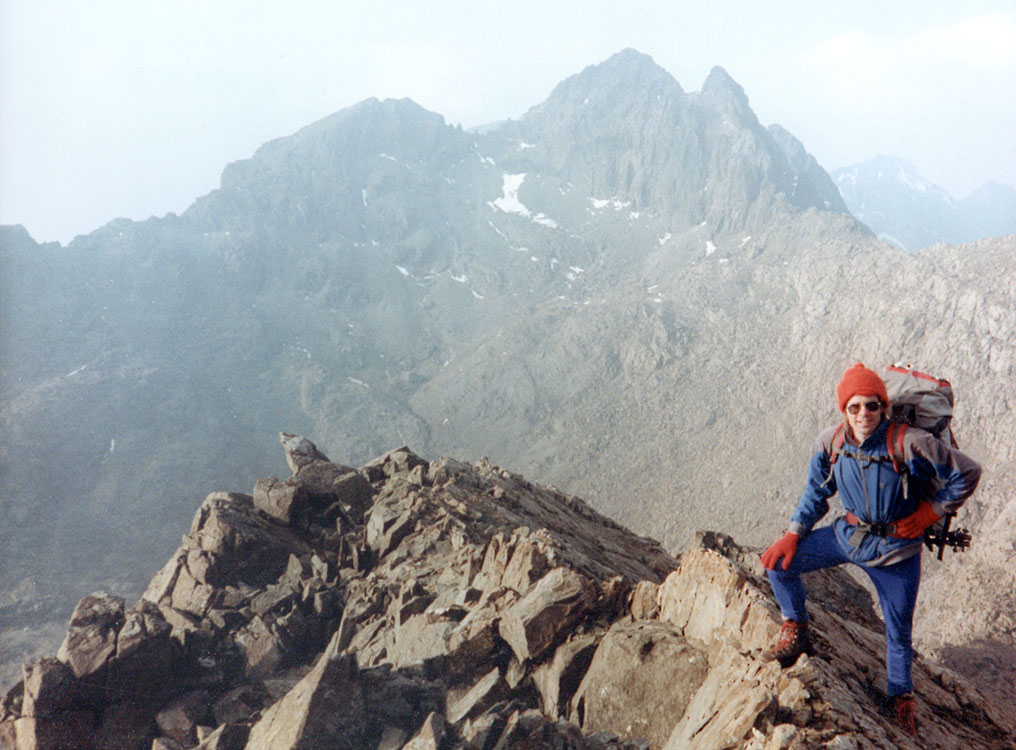
Also I had forgotten just how truly wonderful and unique the Cuillin is: the savagery of the saw-toothed peaks themselves, the mystery of the wreathing mists, the theatricality of the ever-changing atmosphere and the spell-binding luminosity of the light.
On the first day, after visiting the wild and totally unspoiled Tarskavaig Bay on the Sleat peninsula and climbing the small pointed hill of Cnoc Armadail (the first time I’d worn mountain boots since my hip operation twenty weeks ago), we were about to get back into the car when we were treated to a spectacular rainbow that seemed to descend right into the Sound of Sleat only about 400 meters from us. It somehow set the magical, transcendental tone for the week.
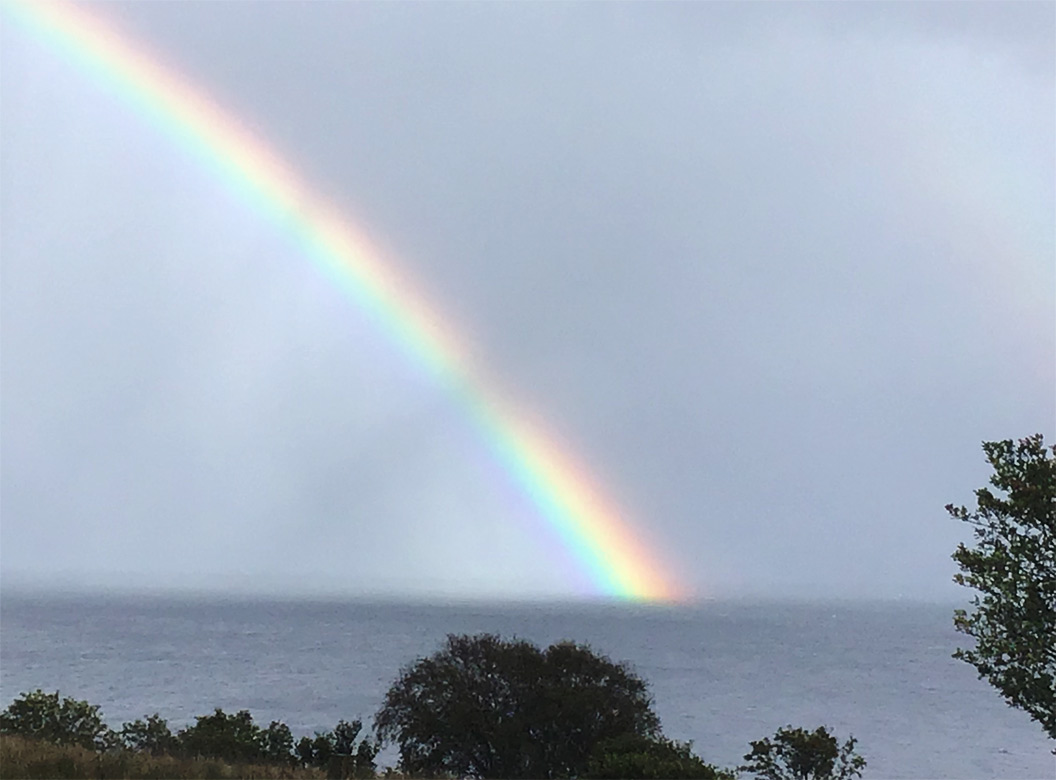
Everything about Skye seemed even better than I remembered it; much is literally better as a result of a huge amount of inward investment since I was last here (roads, quality of service, range of facilities, etc etc). There is almost nothing tacky or tatty about it anymore, as it’s become a prime goal for the international tourist. It must now rate as one of the leading tourist spots of its type in the world.
But there was something else very noticeably different: the sad contrast with England. Almost as soon as we’d crossed the border, it was as if some invisible cloud of sickness had lifted. And by the time we’d reached Skye, after two very pleasant days spent at Rhu near Helensburgh, it was as if we’d returned to the real, normal world that has been so utterly blighted in England by the perverse hate-spreading virus of Brexit. At last, everywhere there were relaxed, happy people, full of good humour and wisdom, who spoke to you directly and not in mealy-mouthed equivocations.
We were staying at Skye Basecamp, a popular hostel for climbers and backpackers in Broadford, run by Mike Lates, my old friend (and great assistant on my Cuillin book in 1993).

Perhaps the greatest benefit of the hostel is the extraordinary number of young, intelligent international travellers who pass through it every day: Canadians, Australians, French, Germans, Poles, Italians, Japanese – I lost track of the number of nationalities. Not that it mattered: what they all had in common was an international spirit of camaraderie, and in the seven days I was there I had more interesting conversations than I’d had in seven months in England.
As my spirits rose, so did the clouds on the mountains. The next day, encouraged by a better forecast, I decided that our goal should be Coire Lagan, because Freda had never visited what surely is one of the wonders of British mountain landscape. There was something indescribably thrilling and reassuring about being back on that ancient, classic mountain path.
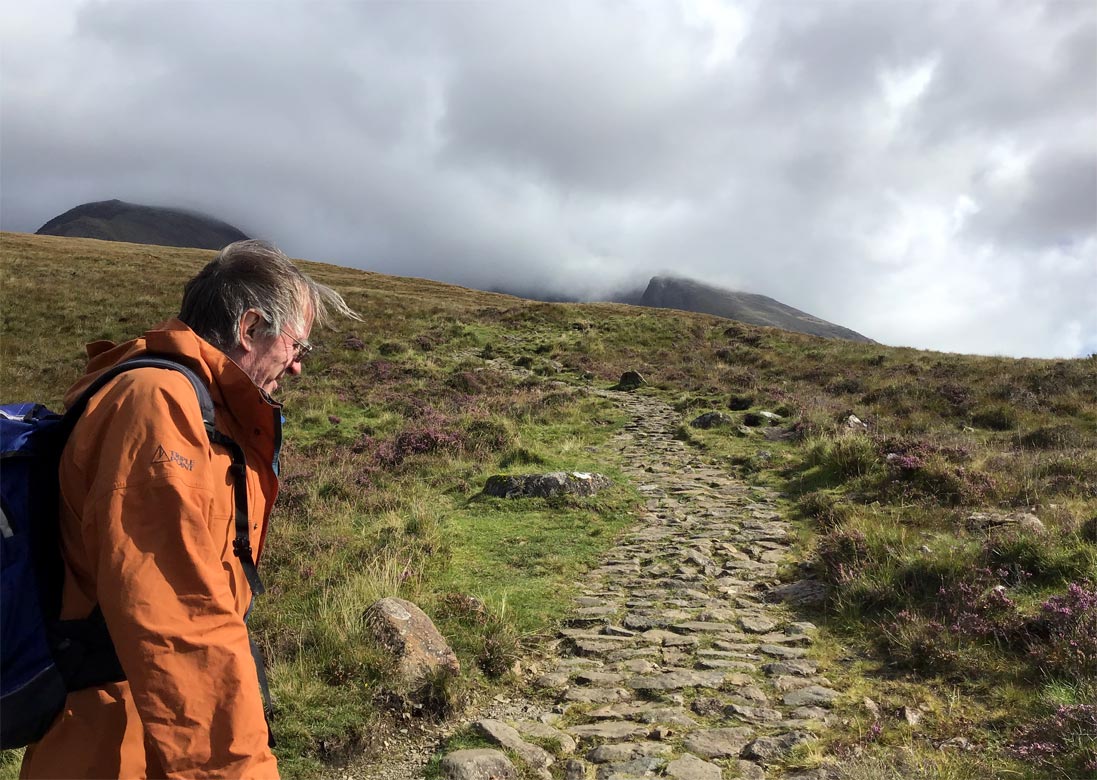
The very first time I ever came up here was in Sept 1975 with the Thames Valley Mountaineering Club, when I took a black and white picture (on a new Asahi Pentax) at around this very spot:
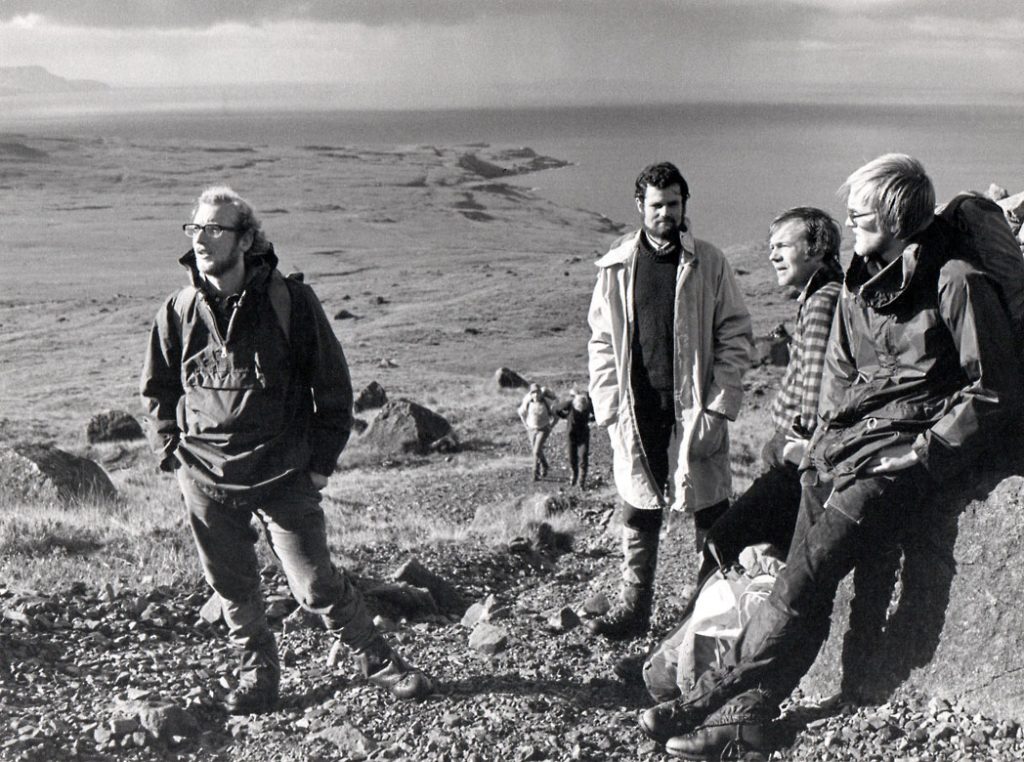
Nothing had changed except the condition of the path, which had been in an appalling state in 1975. Now it had been superbly rebuilt. But the weather conditions were very similar to that day in September 1975, only it had been a rather colder then. My logbook records that later in the day, on the summit of Sgurr Dearg, it had started to snow heavily. Forty-four years later, it rained for a while, so we put on our cagoules:

As we approached the lower Coire, the cloud started to clear in a tantalizing, quintessential Cuillin fashion. Mysterious, theatrical and spell-binding all at once.
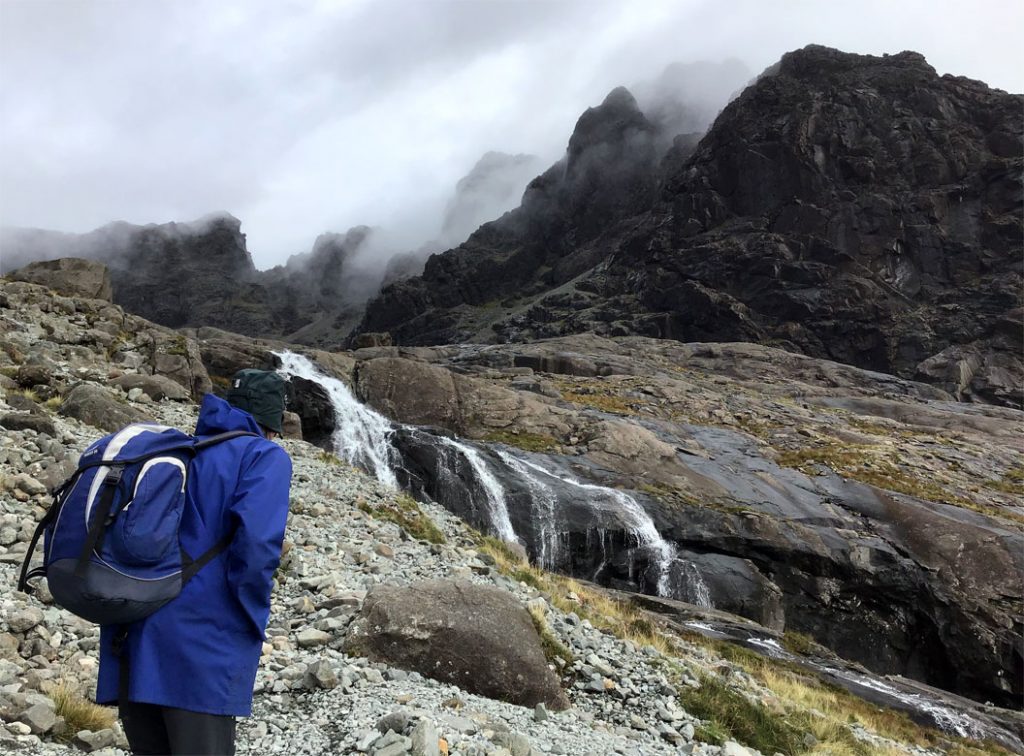
We stopped for a snack once we were in the lower coire, below the giant, 1000-foot high face of Sron na Ciche. Of course, my mind wandered back to old times, as I retraced a classic rock climb I’d done here with Mike Lates twenty-six years earlier …
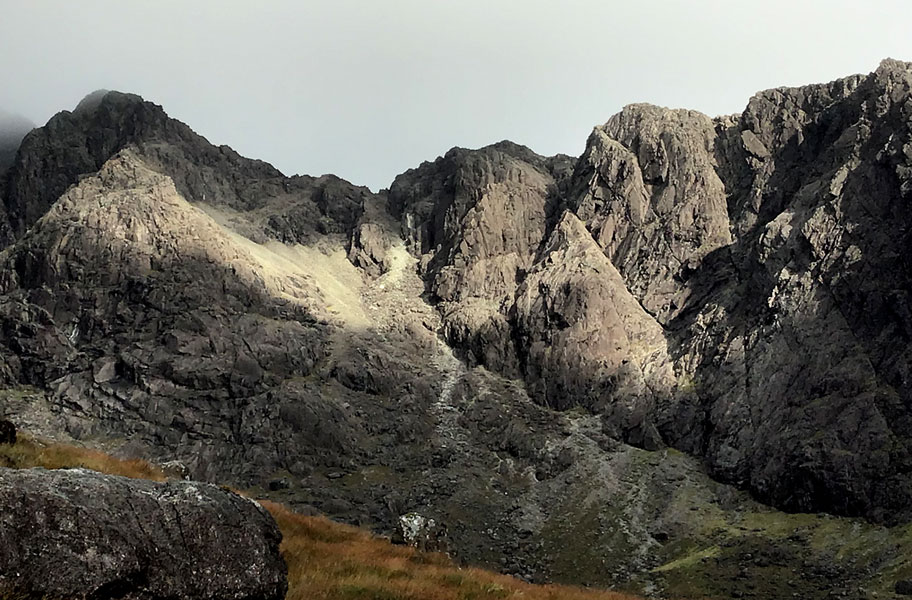
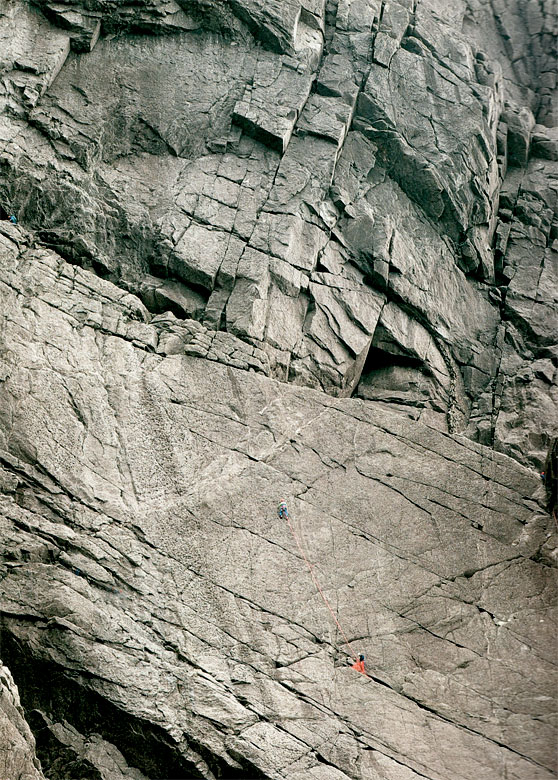
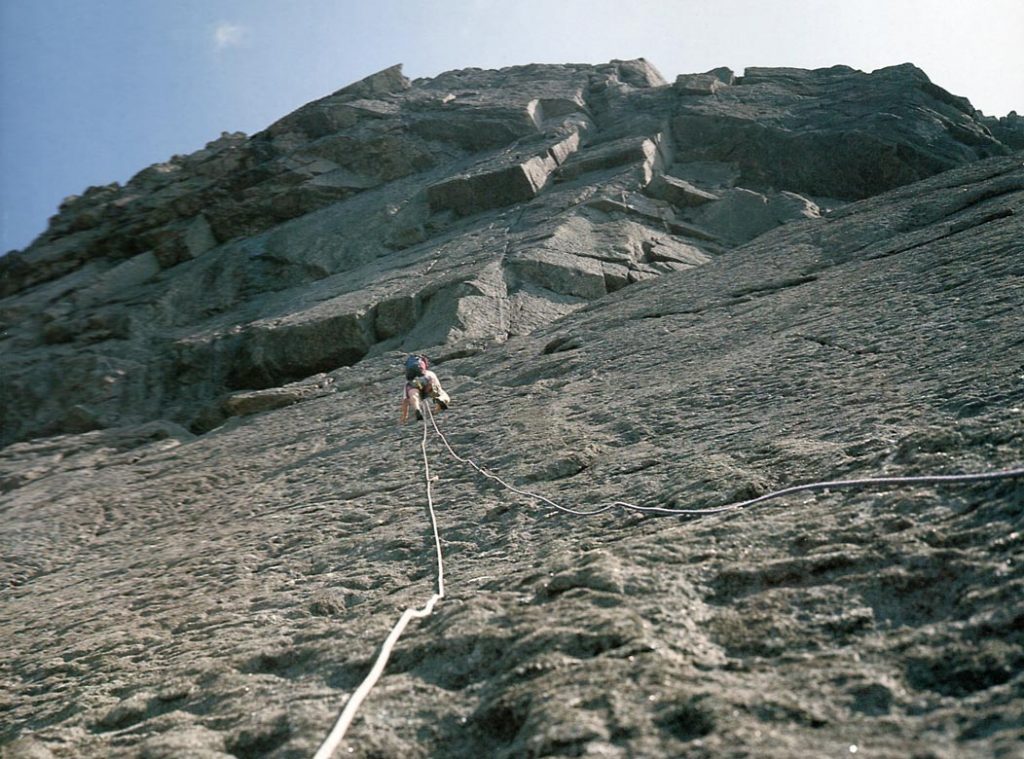
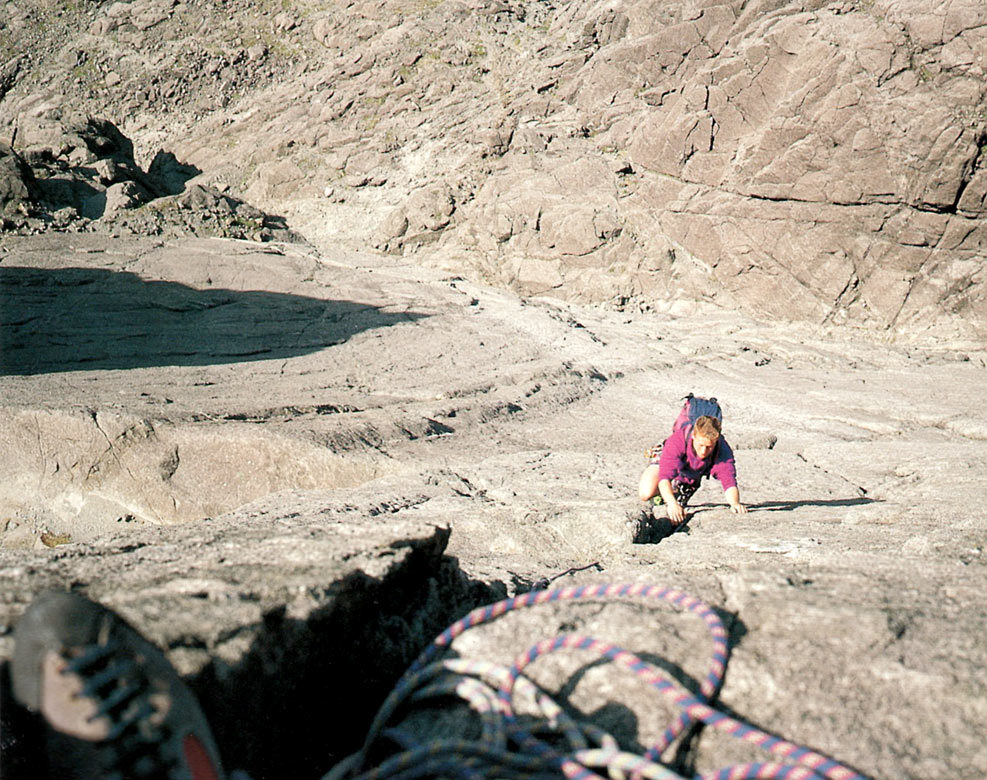

Back to 2019, and I’m confronted by a rock band, a section of very easy rock climbing, to gain access to the the upper coire. It was shortlived, but rather smooth, so I had to take great care …

… but in many ways it was a joy to be climbing on ‘real rock’ again …
Once we were in the superb upper coire we had a pleasant lunch by the lochan, and looked at such well-known features as the Great Stone Shoot and Collie’s Ledge on Sgurr Mhic Coinnich. At one time, the 1200′ Great Stone Shoot from near the summit of Sgurr Alasdair was the longest and finest scree run in Great Britain, but in time the fine scree in the upper gully has ended up on the lower scree slope so that only the lower 400 feet can still be scree run. When I first did it in September 1975 with members of the Thames Valley Mountaineering Club it was still intact, and my logbook records that we came down it in about 10 minutes.
Another exceptionally fine feature is the very exposed Collie’s Ledge on Sgurr Mhic Coinnich …
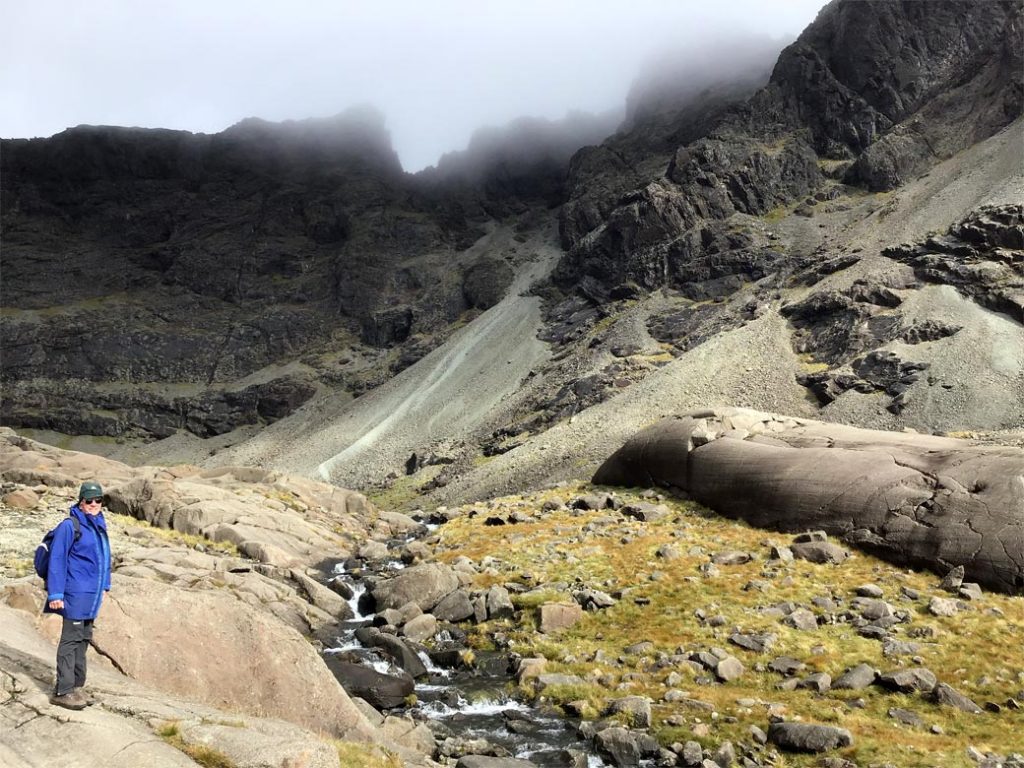
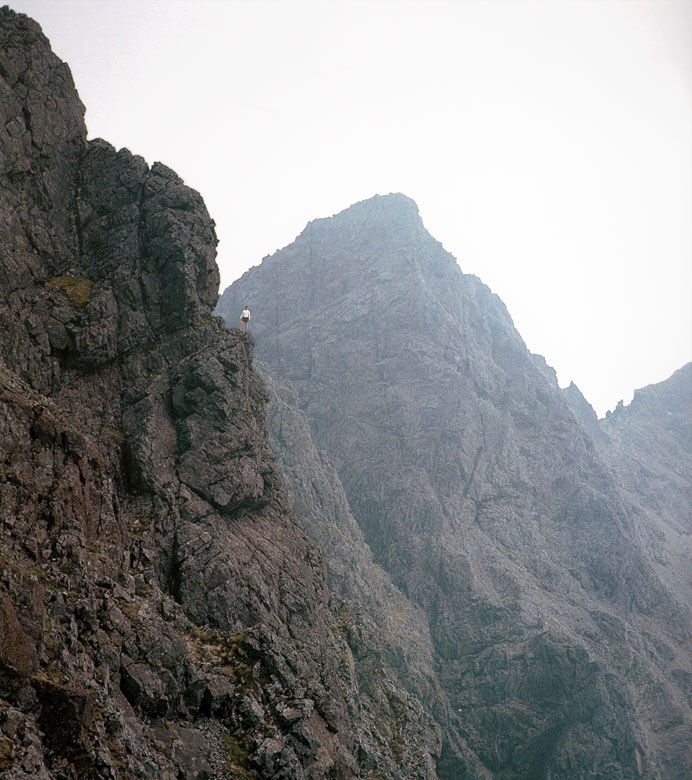
It was time to descend and, although I had to take great care on the final feet few of the rockband, I had climbed 1900 feet without any serious problems with my new hip.
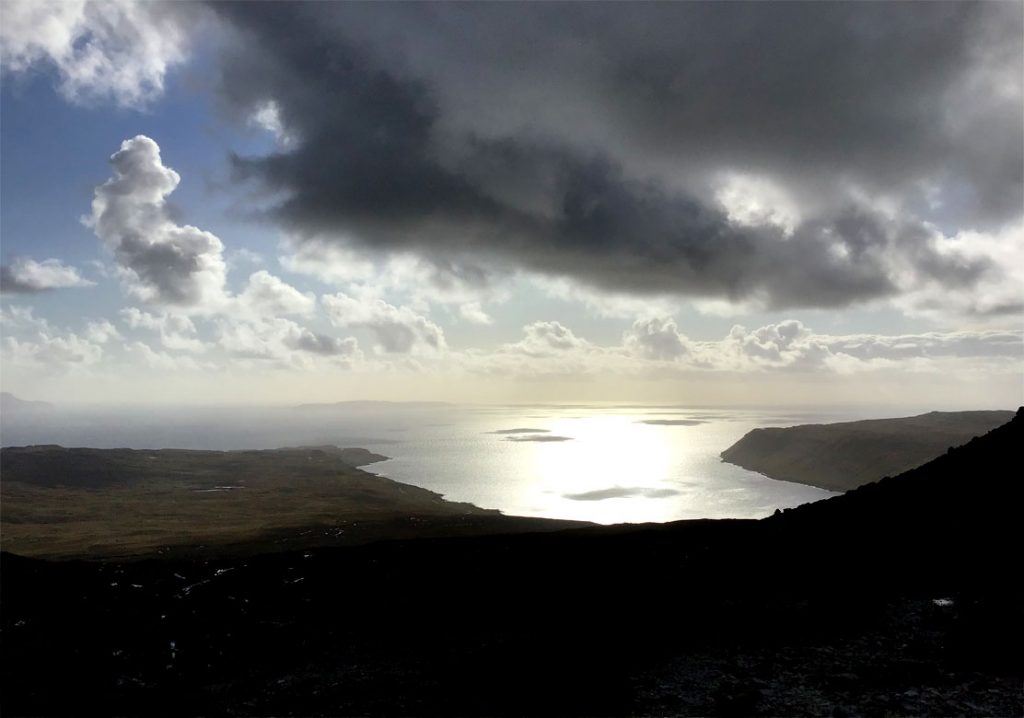
Once we were on the edge of the coire we stopped again to marvel at the extraordinary lighting effects: a sea of dazzling silver, 1500 feet below, flanked by the gigantic black fortress of Sron na Ciche. Black and silver; while at my feet the Ling heather and other flora was a Jackson Pollock painting of orange, red, purple and green. I was seeing everything with an almost new intensity. A large whale-like black boulder in front of me glistened with pinpricks of light twinkling like diamonds as the quartz crystals were enlivened by the evening sun. Literally, twinkling like diamonds.
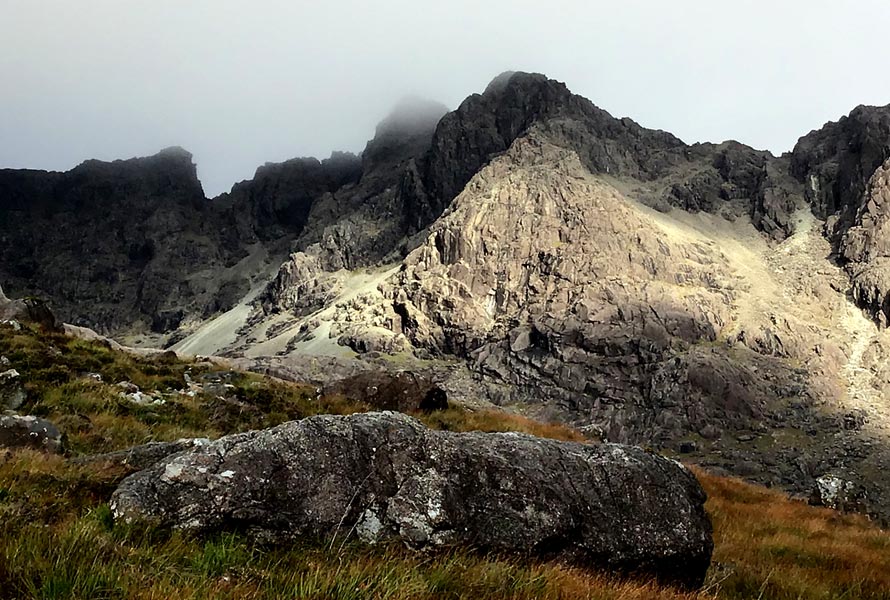
But all such things are fleeting and the next day the cloud was down on the mountains, so we went on a fun ferry crossing to the Isle of Raasay, which we’d never visited, and had a very pleasant woodland walk.
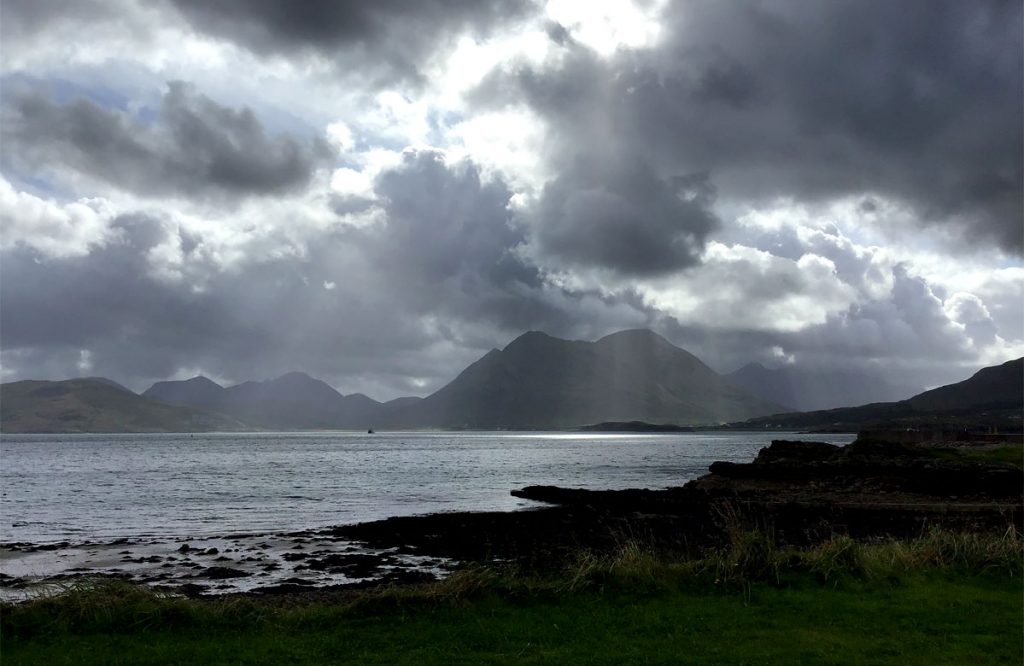
But something had to go wrong, I suppose, on a Friday 13th, and when I decided on our return in the evening to revisit the Sligachan Hotel bar I was shocked by the tasteless way in which it had been revamped.… All very dark grey, ‘post-modern’(?) and uncongenial – whatever ‘mountain soul’ it might once have had totally ripped out of it. One might just as well have been in some kind of motorway cafe in one of the tackier suburbs of London. I vowed not to return.
On Saturday there was monsoonal rain, so we stayed in the hostel all day, reading and talking … On Sunday we visited friends near Portree and, in improving weather, went for a walk on a beach in the Braes:

On Monday, we climbed the very appealing Ben Tianaveig (Chee-anaveg), 1,355 feet, near Portree, that had formed the backdrop the day before. This was quite a challenge for me because the path was steep and slippery in places, and I had to take extreme care, fearful of dislocating my hip. I just could not afford a single slip anywhere. So the climb was rather more of a challenge for me than that into Coire Lagan. The summit views, however, perched over the sea and with a grandstand view of the moody Cuillin, were a stupendous reward.

Tuesday, 17th. Now, at last, the window of good weather that I’d been hoping for arrived. We set our alarm clock for 6.45 am, and before 8 had left the hostel on a perfect fine morning. My ambitious plan for the day was to get back on to the Cuillin Main Ridge at last, by ascending Bruach na Frithe, 3,143 ft, (which translates most curiously and misleadingly as ‘Slope of the Forest’.) Apart from being one of the best viewpoints on the entire ridge, the approach takes one into the stupendous Coire a’ Bhasteir (Corra Vashtyer, Corrie of the Executioner’) below the spectacular Am Basteir with its extraordinary 150-foot high ‘tooth’, shaped like an executioner’s axe – arguably the most extraordinary piece of rock sculpture in Britain, and Sgurr nan Gillean, 3,167 ft, (‘The Peak of the Young Men’) – perhaps the finest peak in Britain (the only other contenders being Sgurr Alasdair and, on the mainland, An Teallach, Lliathach and Suilven.)
The main reason, then, that I chose to climb Bruach na Frithe via Coire a’ Bhasteir was that, even if we failed to reach our objective, it would be a rewarding mountain day. I told Freda that almost wherever we stopped would be a worthy goal, amid spectacular terrain.
The route comes in four stages: a three-mile walk across a bog; a steep rocky scramble up the side of the Bhasteir Gorge, a difficult slog up steep scree below the Executioner (I had serious doubts whether I would be able to manage this with my new hip), and a final easy scramble up the summit ridge to Bruach na Frithe.
The route did not fail to surprise after the passage of a quarter of a century. A superb new path (albeit very rough in places) has been made across the ‘bog’ so that it has virtually disappeared. Indeed, I couldn’t even make out where it was. I think the new path takes a route far to the east of the old one… So this section of the route went easily enough, although it took us over an hour and a half. Then came the second surprise: just how demanding the scramble was beside the spectacular Bhasteir Gorge – a route that I used to scamper up and down with a huge heavy camera sack and tripod, barely noticing it. But the sad truth is that with the onset of old age and failing limbs, the mountains grow both in size and severity….
One of the joys of the route is the way that Sgurr nan Gillean (‘The Peak of the Young Men’) reveals itself and changes its appearance until it is almost entirely unrecognizable, like a well-dressed and affable young man removing his clothes to reveal the strong, sinewy body of a Celtic warrior.
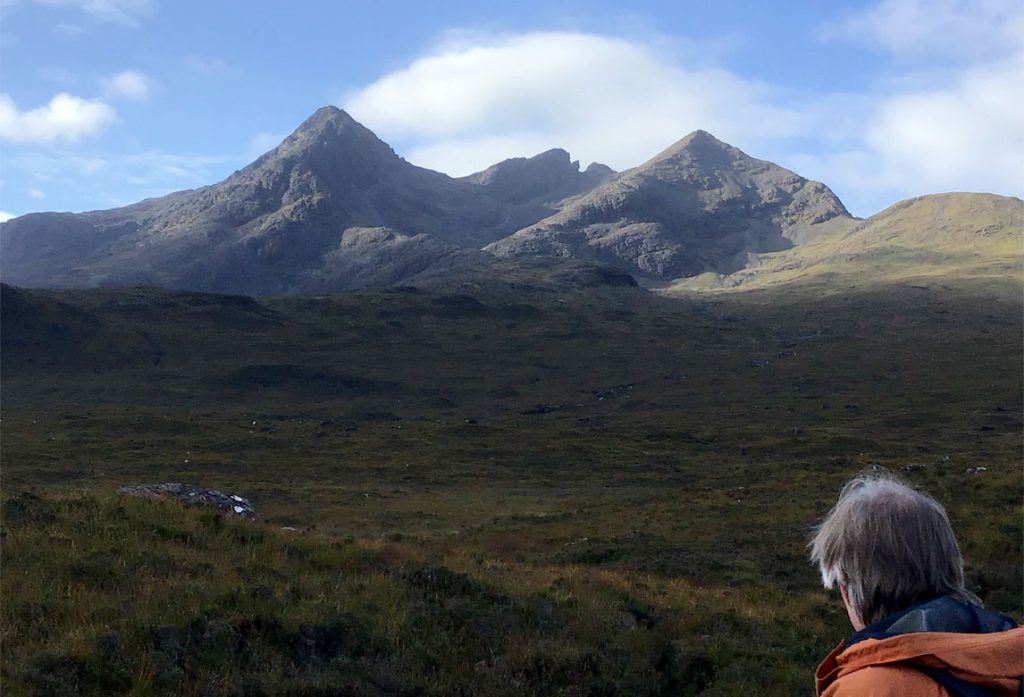
I have always been fascinated by the optical illusions embedded in the three dimensional rock sculptures of the world’s greatest peaks, the Matterhorn being perhaps the prime example. Sgurr nan Gillean is no exception. The way the vast majority of tourists see it from the Sligachan Hotel is highly misleading. From that angle and distance it merely looks like a fine, rather benignly rounded triangular peak. The obvious assumption from the way it looks is that it is a simple whaleback of two broad? ridges running east-west:

Most tourists I think would be amazed to be told just how different the reality is: a three-sided pyramid with south-east, west and northerly ridges, the latter coming straight towards the viewer. Somehow the darkness of the gabbro completely conceals its true topography (B):

But even this is not the exact truth, for the faces between the ridges are not gently angled like those of a pyramid, but are precipitously steep. The north ridge, coming directly towards the spectator, is actually a deeply-serrated narrow blade of five massive pinnacles, their sides vertical in places, half a kilometre in length. The other two ridges are likewise heavily serrated, but not so spectacularly as the ‘Pinnacle Ridge’:
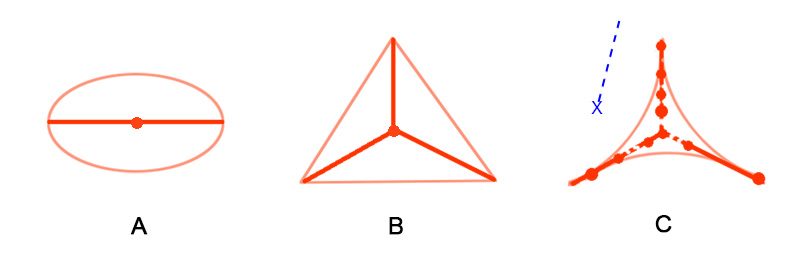
Once we were over the lip of the rock band, the route into the Coire, like everything today, was longer than I remembered but I was delighted at last to be back in this extraordinary mountain sanctuary, directly below the Pinnacle Ridge of Sgurr nan Gillean – so utterly different from the way it appears from Sligachan. (Our position marked by blue X above).
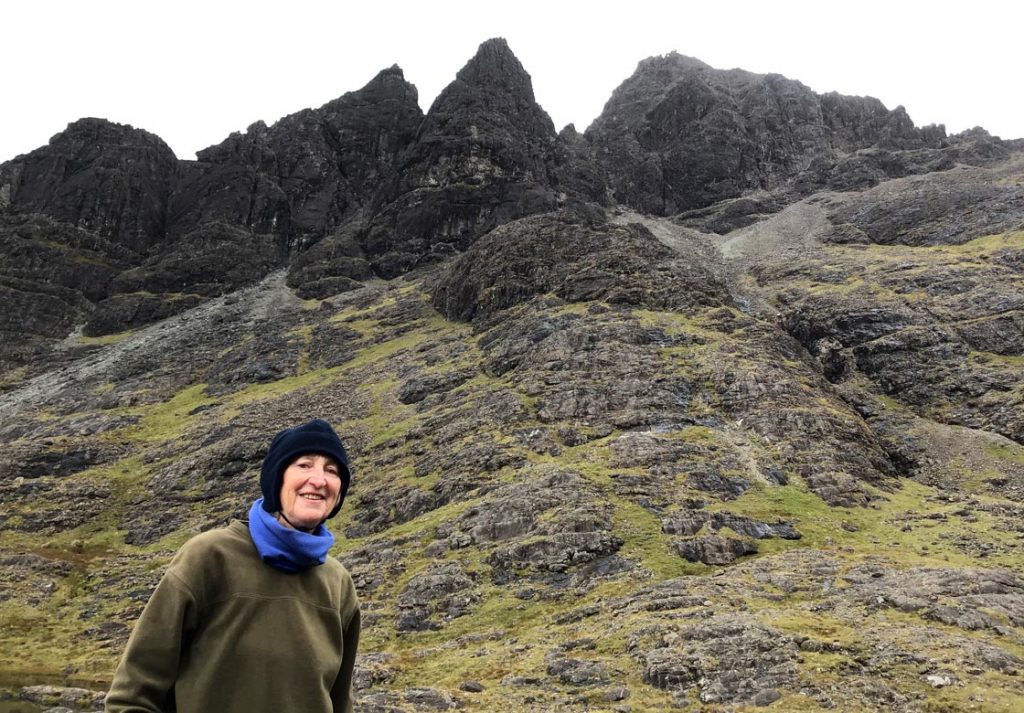
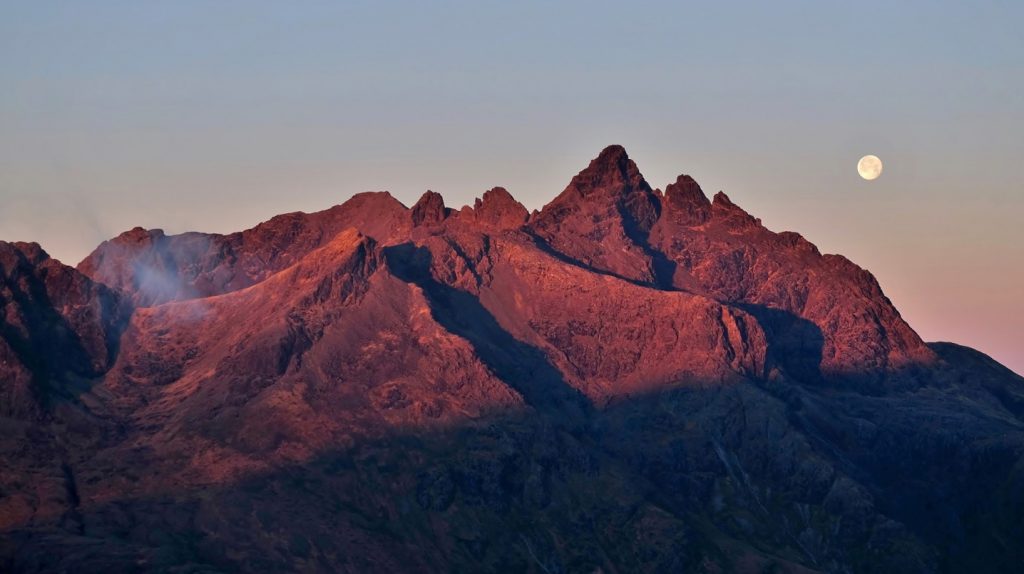
I see from my climbing logbook that I climbed Sgurr nan Gillean five times between 1975 and 1993, and the Pinnacle Ridge twice. The first time I did it was in bad conditions in September 1975 with the Thames Valley Mountaineering Club. I recorded it as ‘an enjoyable mini-epic (in retrospect only!)’ Here’s my logbook account:
‘25th Sept 1975. Weather improved, but far from suitable for the day’s intended route. Set off rather late (11.15) across 3 miles of peat bog to do Pinnacle Ridge (III), Sgurr nan Gilean. Bill catches Pete & myself up to make rope of 3. Solo to top of 3rd pinnacle. In thick cloud. Descending this as last man called for considerable concentration on my part. Steep, greasy rock & now raining. Move together on 4th pinnacle (Knight’s Peak) round gendarmes, then I descend direct to notch – rock v. wet & icy, making this difficult even with a top-rope, so others abseil. Conditions now getting really unpleasant & cold, & now 5.30, so go along grass terrace to left then back R up loose rake to save time. Bill leads last 90’ pitch to summit ridge – good holds, pleasant. Summit 6.00. Then straight off along East Ridge by ‘Tourist Route’ (seemed like a motorway!) V. rapid descent in gathering gloom & increasing rain. Back at Sligachan at 8.00 just before completely dark. Hear news of Everest S/W Face success in pub.’
Eighteen years later, in September 1993, while doing my Cuillin book, I repeated it – this time solo and in fine conditions. Logbook: ‘A wonderful day’. At the 3rd pinnacle I met up with a team of ‘firemen from Fife’ who kindly let me use their abseil rope, and so I avoided the difficult downclimb I’d made on the previous occasion.
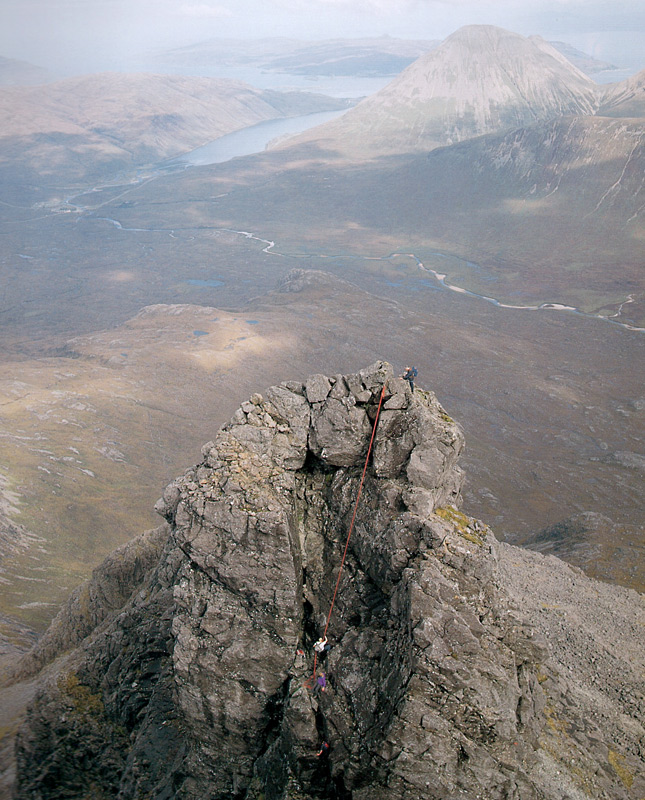
Now, in September 2019, sitting beside the little Loch a’ Bhasteir (marked on the map as being 1949 feet above sea level – rather appropriately the same as my year of birth), all I could do was gaze up at the Peak of the Young Men. For I knew also that this would have to be the high point of our day, indeed of our trip. The weather was looking threatening, and my hip was starting to hurt.
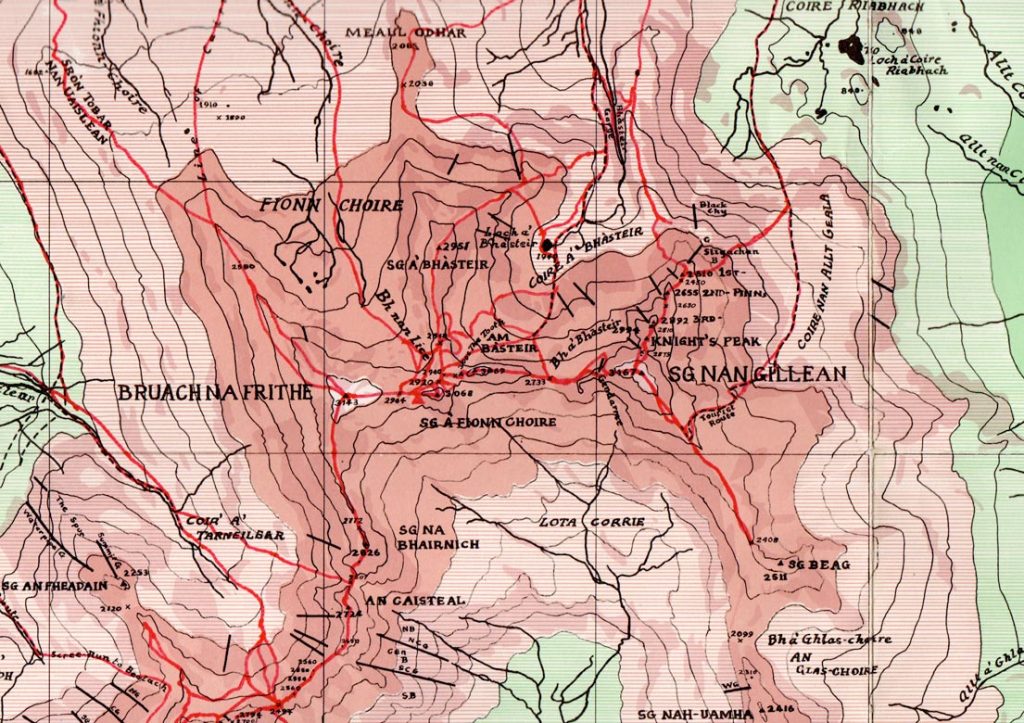
On the descent, Freda and I somehow managed to come down slightly too far to the north, and found ourselves on a final traverse, out of balance on wet rock and having to use quite small finger holds and underpulls – almost rock climbing. Freda, leading the way, had to point out every foothold for me, because I could not see them at all well owing to the ‘macular pucker’ in my right eye. Fortunately, the difficulties were short lived, but we hugged each other on regaining the safety of easy ground. Freda was very generous about how well I had managed with my dual handicap. But what would I have thought if I could have looked forward a quarter of a century in 1993, and seen myself now …?
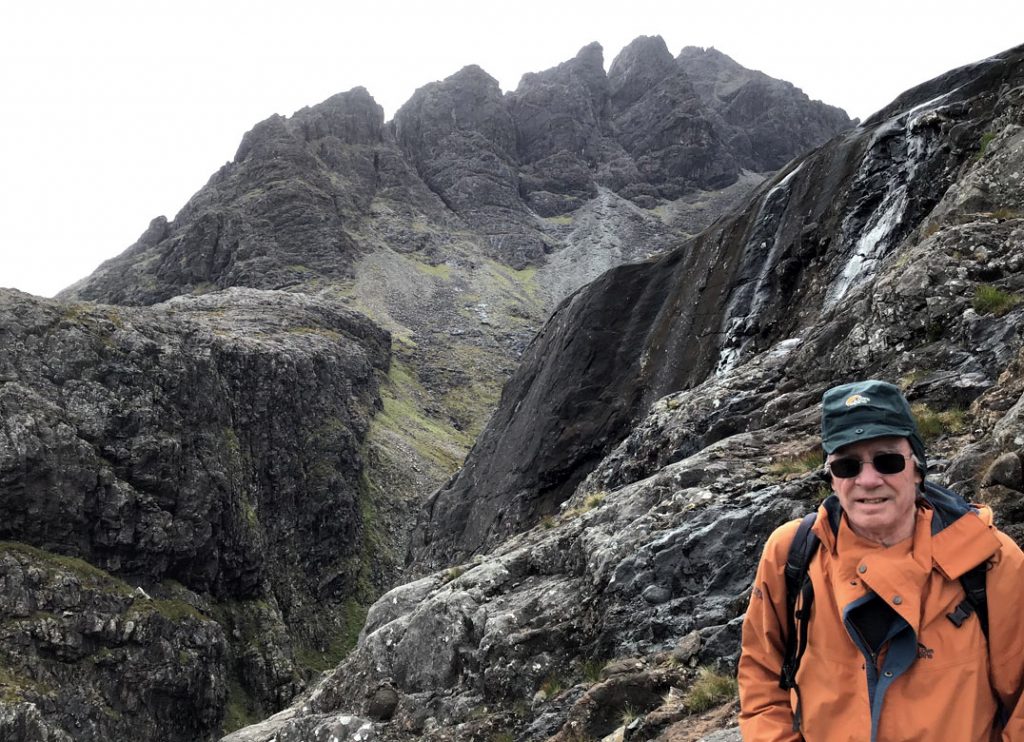
My hurting hip made the return to Sligachan quite an ordeal, and by the time we’d reached the car, I was completely spent. The day had been right at my limit – it had ‘given me a spanking’, to use a favourite expression of one of my old climbing friends. Nevertheless, it had been truly superb, having all the very special qualities of a mountain day, that is so different from all other days in ordinary life.
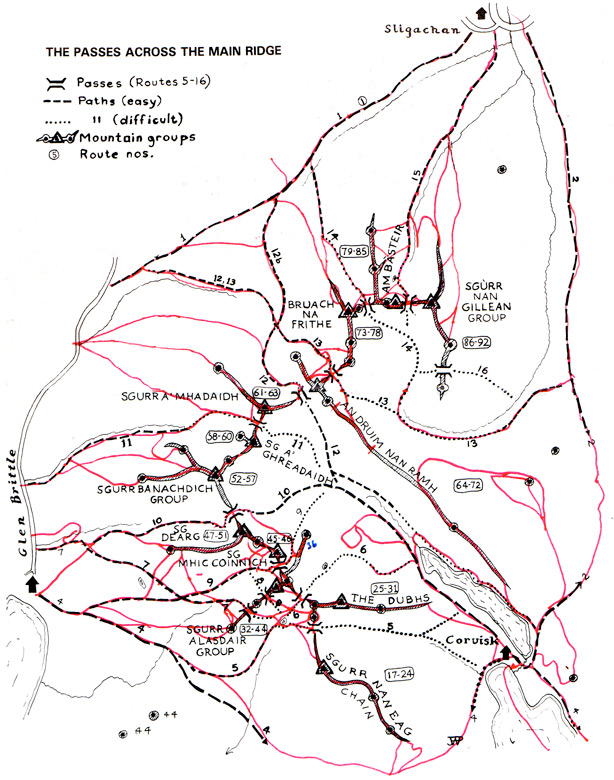
All we are left with after a day like this are our memories – that become superimposed on the map of all our previous memories – but how rich and rare they are, of a kind given perhaps only to a fortunate few.
We drove home the next day in perfect weather to dear old England, our ‘green and pleasant land’ now so horribly tainted by the lies and lunacy of Boris Johnson … How I would love to swing him on a rope above a huge drop (e.g. from the Basteir Tooth) to try and make him come to his senses, try to make him understand all that is best about life that has so obviously eluded him.
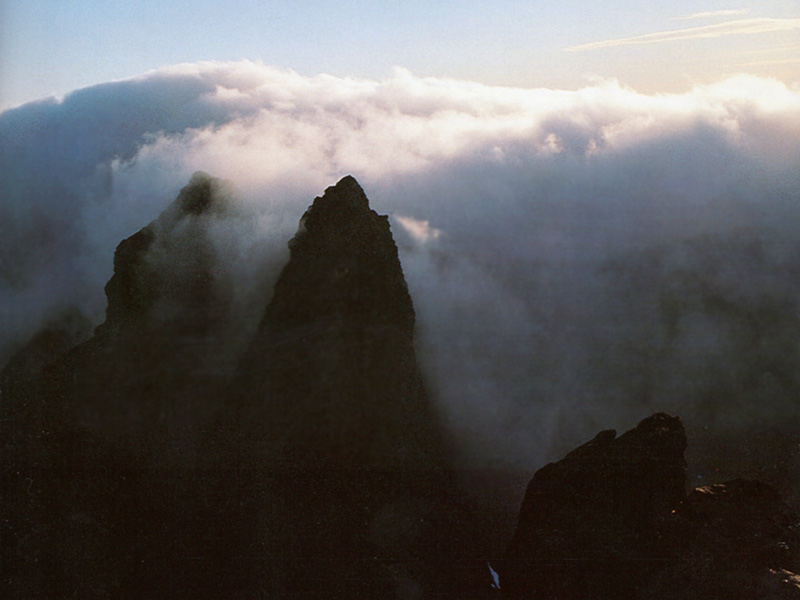
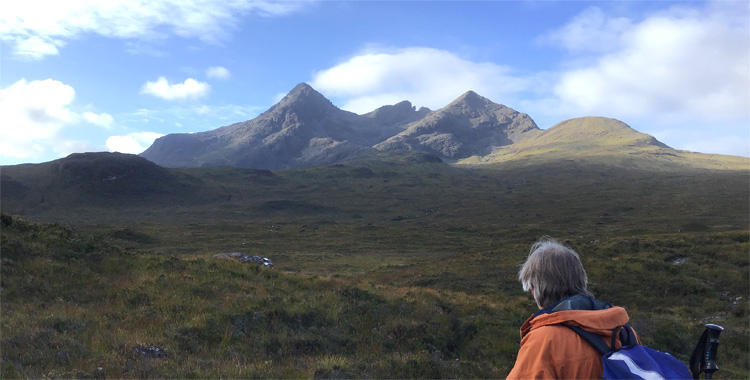
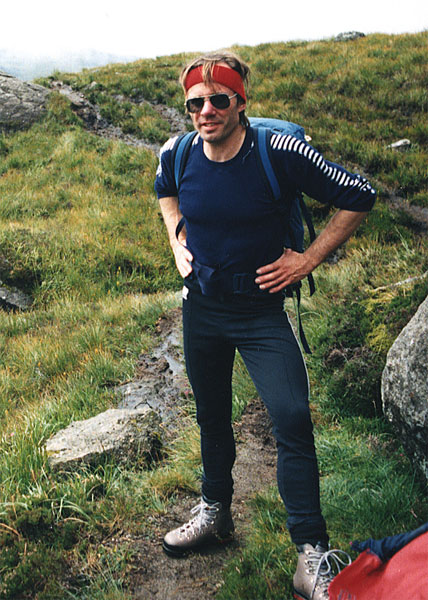
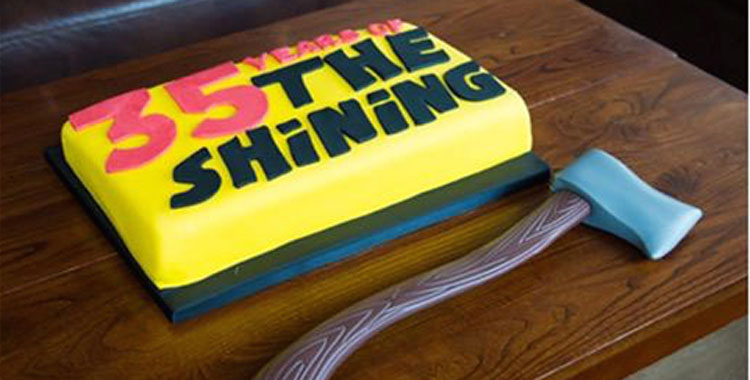
Great commentary, Gordon
Thanks 🙂
A great read about your adventure in Skye/Scotland. Sounds like you pushed yourself to the limits, but it’s remarkable how well you preserved on your new hip. You should give yourself a great deal of credit for having accomplished as much strenuous hiking as you did.
Sounds like a majestic place. In Scotland, I only ever visited Edinburgh and did not venture out into the beautiful country side. Your post here clearly shows it’s worth a visit.
No, I was very feeble compared with what I once was.
The Cuillin is almost as freakily ‘different’ as the Grand Canyon, in its own way. The mountains of the very far north-west of Scotland are pretty freaky too. There are a lot of problems with the Scottish highlands, though – weather, midges, v short days in the winter – so you have to pick the right time of year, and even then, strike lucky. The mountains ‘live’ a lot of the time in the cloud and mists, and you really have to ‘pounce’ when the weather turns good, sometimes only for a few hours. But that’s all part of its nearly unique charm. Though obviously not as ‘charming’ in this respect as Patagonia 🙂
well, I still give you a lot of credit for your efforts!
Yes, definitely seems like there are only limited windows of good weather.
And I meant persevered not preserved in my original post 🙂
love, LJ xoxo
Well, I dragged my creaking carcass up to 2000′! And, yes, the Cuillin is all about limited ‘windows’ – but that in a way is what makes it so special.